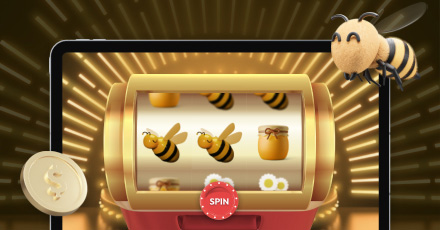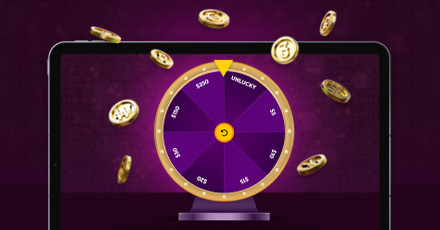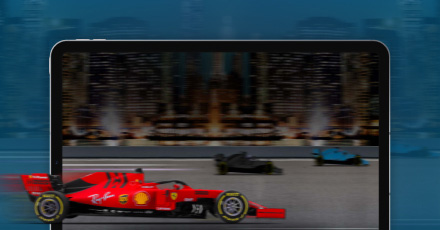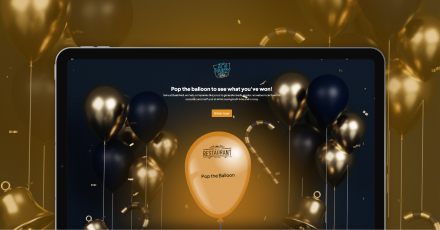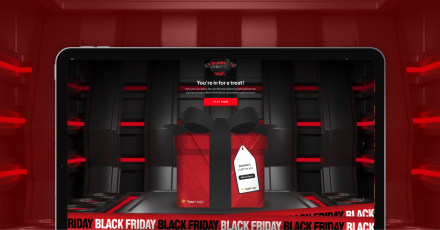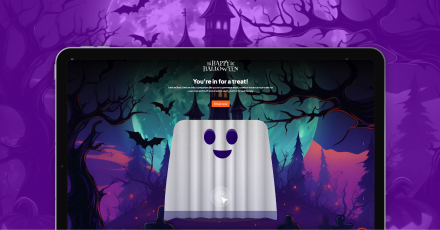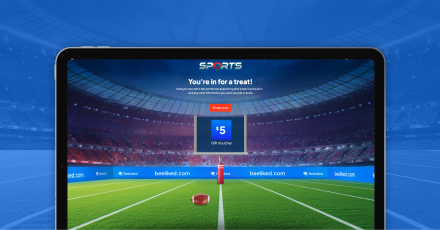Gamification is a hot topic of conversation in many industries. But did you know it’s an amazingly effective strategy in the workplace? If you’re not sure what gamification is but would like to learn more about why it’s important and how you can implement it in your business, this post is going to help.
Mixing gaming elements with work improves employee productivity and engagement by a considerable amount. Don’t believe us? Here are some interesting statistics to illustrate the point.
- 90% of employees say gamification makes them more productive
- Companies that use gamification are seven times more profitable than those that do not
- 72% of people say gamification motivates them to do tasks and work harder on the job
- On average, employees experience a 48% engagement increase with a gamified work experience.
What Is Gamification in the Workplace?
Gamification in the workplace is a strategy you can adopt to make work more interesting. It involves incorporating challenges and tasks, making work more likable and less stressful for employees. As any guide to gamification will tell you, it’s not a complicated concept.
Yes, gamification is fun. But that doesn’t mean it turns the working day into a game. On the contrary. It mixes game mechanics with work to make it more interesting, improve employee engagement, and increase productivity.
Benefits of Gamification in the Workplace
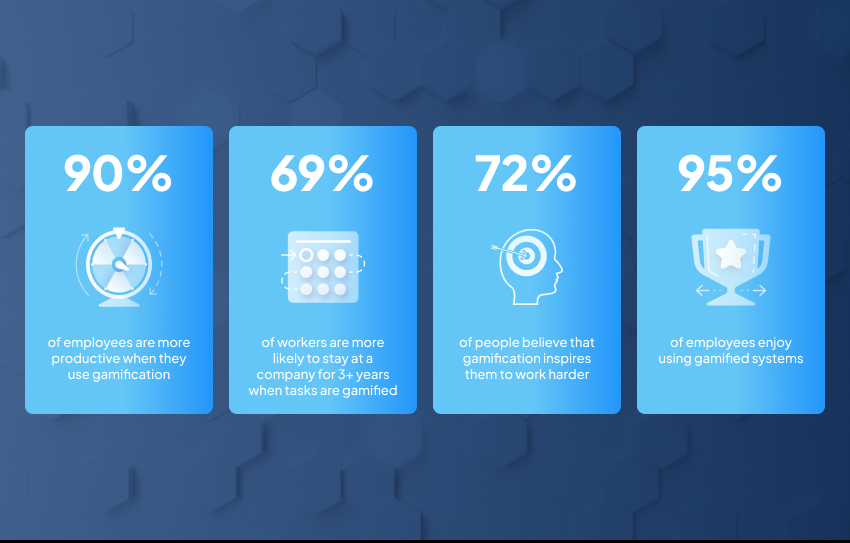
The benefits of gamification for any workplace can be astounding, particularly when incorporated into workforce training. This is just one of many gamification use cases. Another great example is a remote workforce, where employees are working around the world and may not get much face time with each other.
Let’s look at some of the key benefits of using workplace gamification.
Boosts Employee Engagement
Gamification improves employee engagement by making training more interactive and enjoyable. It also provides instant feedback and recognition, which in turn motivates employees to perform better.
Increases Retention
When gamification is incorporated into everyday work and training it helps make mundane tasks fun. As a result, it increases employee skill retention by as much as 40%.
Brings Fun to Everyday Tasks
A gamified reward system makes essential workplace activities and tasks less monotonous and dull and less unpleasant to perform.
Improves Communication
Gamification creates clear and consistent lines of communication. It drives employees toward goals consistently and clearly, thereby reducing the need for further clarification.
Everyone is on the same page and knows what they need to do to complete processes. Communications can be made more concise and transparent by referencing achievements in games because there are already clearly defined goals.
Fosters Friendly Competition
Companies use gamification to help create internal competitions to instill a sense of healthy competition within the workplace. Gamification can significantly enhance employee engagement and productivity through friendly competition.
One way to gamify workplace competition is by creating a points-based leaderboard, which can be used to track progress and reward top performers.
How Do HRs Use Gamification
In HR, gamification is used to improve employee engagement, reduce absenteeism and turnover, and make HR tasks more fun and interactive. Gamification techniques can help with:
- Screening candidates
- The onboarding process
- Training
- Team chemistry
- Evaluating employee performance.
Companies that Use Gamification in the Workplace
Some real-life examples of companies use gamification in the workplace are:
- Google: Google’s famous billboard math puzzle is an excellent example of how gamification can be used in recruiting. Other examples include coding tests or using a service such as HR Avatar that asks candidates questions.
- Deloitte: This company provides new employees with an interesting onboarding experience. They are grouped into teams that work together to answer questions on compliance, company ethics, and procedures. They also provide virtual office tours for newcomers who can access it like a video game.
- AstraZeneca: In this company, a gamification training system called Go-to-Jupiter is used to teach sales staff about the most important products. Leaderboards, levels, and rewards are included, and it’s reported that 95% of employees complete every training module.
5 Ideas for Gamification at Work
You’ve already seen how gamification in the workplace can increase engagement and motivation, but how do you unlock these benefits? Here are some ideas you might want to try.
- Interactive Leaderboards
Leaderboards are a popular gamification element that companies can use to track and display employee performance metrics. They can be used to create internal competition among employees, which in turn helps increase productivity and engagement. Leaderboards can also be used to reward employees who perform well, which helps boost morale and motivation.
Leaderboards must be designed in a way that’s fair and transparent. Employees should be able to see how their performance is being measured and how they rank compared to their peers.
- Spin-to-Win Bonuses
With spin-to-win bonuses, you can make the workplace more fun, rewarding, and collaborative. Something like BeeLiked’s spin-to-win game will keep employees interested in what happens next. If the bonuses are luck-based, they can be used to boost employee engagement.
- Badges for Achievement
Gamification badges are a popular way to motivate employees and create positive change in the workplace. The badges are small tokens of achievement that represent the successful completion of activities or milestones. They can be awarded for all kinds of different actions, such as completing a challenge, project, or other activity.
- Lucky Draws
Lucky Draws are a luck-based game where participants have the chance to win prizes. They can be used as a part of internal competitions to engage employees in a healthy ‘race’ and incorporate scores, levels, and prizes as extra motivation. Lucky draws can also be used to attract potential job candidates. BeeLiked’s grabber game is a very simple lucky draw game based on the traditional grabber or claw game you’d find at a fun fair.
- Intermittent rewards
Intermittent rewards increase employee engagement by adding a sense of spontaneity. Rewards are given out randomly and unexpectedly, which adds an element of surprise and excitement to the workplace.
Intermittent rewards can be used in various ways, such as providing on-the-spot recognition certificates for good behavior or performance. Using this type of gamified approach will make employees more likely to learn and repeat good behavior after receiving unexpected rewards.
How to Implement Gamification at Work
If gamification is not used correctly, the effect it has on employee productivity, happiness, and engagement will be negligible. Here are some tips to help you introduce gamification and benefit from the best results.
Use Games of Chance
You must choose the right tools and technologies that are suitable for your business. For example, why not try some of BeeLiked’s games which include spin-the-wheels, grabber games, unwrap the gifts, and scratch-off games? Games of chance bring teams together and foster communication among employees.
Communicate the End Goals
To implement gamification at work you have to be sure of the end goals. Do you want to increase employee engagement, improve efficiency, or develop skills? Once you’ve identified the goals it’s important to communicate what they are with employees.
Include Gamification in Training
A good place to start with workplace gamification is training employees and onboarding new hires. Rather than boring workers with long, static seminars, you can gamify the process and excite, engage, and educate trainees using quickly completed gamified microlearning modules.
Choose Tempting Rewards
Humans are motivated by intrinsic rewards and motivators, so why not make the most of this natural inclination by rewarding the right behaviors and celebrating progress? Many organizations offer real-life rewards to winners, including gift cards or credit for company swag.
Track Success
Use gamification in the workplace to track success by incorporating challenges, rewards, and recognition. It can be used to track success by creating competitions for sales, product knowledge, or leads.
Other ways it can be used include establishing leaderboards, promoting information sharing, and tracking metrics such as user logins, time spent on certain tasks, and time spent on a platform. Tracking KPIs is another use of gamification, along with employment satisfaction surveys, and other modes of feedback.
Gamify Your Employee Engagement Program
BeeLiked is a company that can help you realize your goals when it comes to engaging and incentivizing employees. There are many diverse types of gamification such as games of chance, quizzes, or challenges and our platform hosts a range of pre-built promotion-type templates including slot machines, mystery boxes, grabbers, and loyalty programs.
Use these solutions to educate, motivate, and engage your employees while optimizing workflows and attracting top talent at the same time.
Wanna see how BeeLiked can help you? Try our employee engagement rewards platform!


